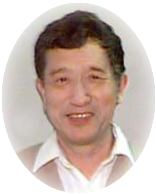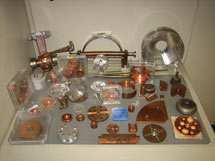
Handy Links
SLAC News Center
SLAC Today
- Subscribe
- Archives: Feb 2006-May 20, 2011
- Archives: May 23, 2011 and later
- Submit Feedback or Story Ideas
- About SLAC Today
SLAC News
Lab News
- Interactions
- Lightsources.org
- ILC NewsLine
- Int'l Science Grid This Week
- Fermilab Today
- Berkeley Lab News
- @brookhaven TODAY
- DOE Pulse
- CERN Courier
- DESY inForm
- US / LHC
SLAC Links
- Emergency
- Safety
- Policy Repository
- Site Entry Form

- Site Maps
- M & O Review
- Computing Status & Calendar
- SLAC Colloquium
- SLACspeak
- SLACspace
- SLAC Logo
- Café Menu
- Flea Market
- Web E-mail
- Marguerite Shuttle
- Discount Commuter Passes
-
Award Reporting Form
- SPIRES
- SciDoc
- Activity Groups
- Library
Stanford
Around the Bay
People: Juwen Wang

Polished pieces of copper, aluminum and stainless steel rest neatly on a table top in Juwen Wang's office at SLAC, looking like a carefully constructed museum display. Though shiny and crafted, the parts no longer have any real value other than the sentimental weight they carry for Wang. The pieces are all parts of accelerators—some just test versions and others that were once operational. The collection is like a "metal scrapbook" of Wang's career, left over pieces of the numerous machines that Wang has spent thirty years developing.
While his work has rippled out to the worldwide accelerator community, Wang's home in the United States has always been at SLAC. This year, his colleague and former graduate advisor Gregory Loew, deputy director emeritus of SLAC, gathered recommendations for Wang and nominated him as a Fellow of the American Physical Society, an honor bestowed to less than one half of one percent of APS members. Wang accepted the fellowship in December. From the APS citation, Wang is awarded the fellowship:
For his leadership in designing, building and testing a large variety of disk-loaded accelerator structures for electron-positron linear colliders and his pioneering studies of RF breakdown in these structures.
Wang is originally from China, and in the mid 1960s he attended the prestigious Tsinghua University (known as China's equivalent of MIT) in Beijing, where he was able to major in accelerator science. He was a top student. He impressed his teachers, began graduate work early, and was on track for a career in accelerator science by the late 1960's.
But the Cultural Revolution cut his plans short. All higher education in the country ceased, and Wang went to work fabricating railway equipment in a factory. When his engineering skills were recognized, he was transferred to design radio equipment for China's merchant marine. For nearly twelve years, Wang remained separated from physics, yet he doesn't talk about this period with any bitterness. It could be that Wang isn't the kind of person who lets himself be upset by the past. Or perhaps it's because the temporary detour led to another important path in his life, represented in photographs hanging on the wall of his office. The photos feature a beaming toddler, Wang's grandson, Evan. The manager at the Beijing factory had introduced Wang to his wife, and many years later he is now a proud grandfather.
When the Cultural Revolution ended, Wang was free to resume his graduate work at the university. In 1979, a new policy of cooperation began between laboratories in the US and China, and the two countries began sharing information and expertise. Loew, then head of the SLAC Accelerator Physics Department, went to China to teach accelerator science at a handful of institutions, and met Wang.
"Everybody knew that SLAC was at the frontier of linear accelerators," Wang said. "So naturally, my goal was to come to SLAC." Loew hadn't planned on bringing a student back with him, but Wang's wishes were clear, and his teachers recommended him strongly. So, the two men made arrangements to have Wang come to SLAC as a visiting scientist.
"I found myself, pretty quickly, to be a member of this big family, this big community," Wang said of his early days at SLAC. He worked at the lab for almost two years and eventually was able to find funding from Stanford to pursue his PhD.
Wang's first work at SLAC focused on improving designs of room temperature linear colliders, and he has continued that work to this day. In his nomination letter for the APS fellowship, Loew wrote that Wang, "is without doubt the foremost expert at SLAC on designing, building, tuning and testing linac structures." Working closely with scientists at the physics lab KEK in Japan, Wang contributed greatly to plans for a proposed room temperature International Linear Collider. Although those plans were passed up in favor of a superconducting linear collider, the work Wang did still contributes greatly to the field. Currently, in a collaboration with KEK and CERN, he is responsible for the planning, fabrication, tuning and characterization of the test structures for the Compact Linear Collider or CLIC project at CERN. This project is currently exploring the feasibility of creating a cost efficient electron–positron collider with energies in the TeV range. Because of his work in the US and Japan, Wang gained international recognition as an expert on building new and complex room temperature accelerators. He also contributed to the Linac Coherent Light Source at SLAC, by doing research and development on the LCLS injector and deflectors.
"He looked at everything that had to go into the design of these accelerator structures," Loew said. "He is very much at the center of the activity, and that's what makes him so valuable to the lab."
Wang, humble and thankful for his long and prosperous career, gives a lot of credit to the people he's worked with at SLAC. He proudly keeps the little museum in his office, which he'll gladly describe to anyone who drops by and asks. He said that when he arrived at SLAC, it was a challenge to get out and meet everyone that he needed to work with. Now it comes naturally. "I have to collaborate. I have to interact with people. There are so many ideas and so much work."
—Calla Cofield
SLAC Today, January 6, 2010
